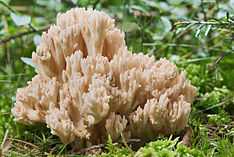Ramaria formosa
| Ramaria formosa | |
|---|---|
 | |
| Scientific classification | |
| Kingdom: | Fungi |
| Division: | Basidiomycota |
| Class: | Agaricomycetes |
| Order: | Phallalles |
| Family: | Gomphaceae |
| Genus: | Ramaria |
| Species: | R. formosa |
| Binomial name | |
| Ramaria formosa (Pers.) Quél. | |
| Ramaria formosa | |
|---|---|
|
| |
| smooth hymenium | |
| no distinct cap | |
| hymenium attachment is irregular or not applicable | |
| stipe is bare | |
| spore print is yellow | |
| ecology is mycorrhizal | |
| edibility: poisonous | |
Ramaria formosa, commonly known as the beautiful clavaria, handsome clavaria, yellow-tipped- or pink coral fungus, is a coral fungus found in Europe and North America. It is widely held to be mildly poisonous if consumed, giving rise to acute gastrointestinal symptoms of nausea, vomiting, diarrhoea and colicky pain. It is a pinkish, much-branched coral-shape reaching some 20 cm (8 in) high. Some forms collected in North America often lack the bitter taste common to European specimens and may represent a different species.
Taxonomy
It was initially described by Christian Hendrik Persoon in 1797 as Clavaria formosa. In 1821, Elias Magnus Fries sanctioned the genus name Clavaria, and treated Ramaria as a section of Clavaria.[1] It was placed in its current genus by French mycologist Lucien Quélet in 1888. The generic name is derived from Latin rāmus 'branch', while the specific epithet comes from the Latin formōsus 'beautiful'.[2] There is some confusion over its classification as there is evidence the binomial name as been applied loosely to any coral fungus fitting the description, and thus some collections from North America may be a different species.[3] Common names include beautiful clavaria, handsome clavaria, yellow-tipped- or pink coral fungus.
Description
The fruiting body of Ramaria formosa grows to a height of 20 cm (8 in); it is a many-branched coral-like structure, the yellow tipped pinkish branches arising from a thick base. Terminal branches are less than 0.5 cm in diameter. The flesh is white, an important feature as edible members of the genus have yellowish flesh. Old specimens may fade so the original colour is hard to distinguish. The spore print is yellow. The smell is unpleasant and taste bitter. [4] However, the taste has been reported as indistinct in North America.
Distribution and habitat
Fruiting in autumn, Ramaria formosa is associated with beech and is found in Europe,[5] and North America. Forms from the western areas are known to occur under conifers.[3]
Toxicity
Consumption of the fungus results in acute gastrointestinal symptoms of nausea, vomiting, colicky abdominal pain and diarrhea. The toxins responsible are unknown to date. It has been reported as edible if the acrid tips are removed.[6]
References
- ↑ Fries EM. (1821). Systema Mycologicum (in Latin) 1. Lund, Sweden: Ex Officina Berlingiana. p. 466.
- ↑ Simpson, D.P. (1979). Cassell's Latin Dictionary (5 ed.). London: Cassell Ltd. p. 883. ISBN 0-304-52257-0.
- ↑ 3.0 3.1 Ammirati, Joseph F.; James A Traquair and Paul A Horgen (1985). Poisonous mushrooms of the northern United States and Canada. Minneapolis: University of Minnesota Press. pp. 306–08. ISBN 0-8166-1407-5.
- ↑ Zeitlmayr, Linus (1976). Wild Mushrooms: An Illustrated Handbook. Garden City Press, Hertfordshire. p. 108. ISBN 0-584-10324-7.
- ↑ Nilson S, Persson O (1977). Fungi of Northern Europe 1: Larger Fungi (Excluding Gill-Fungi). Penguin. p. 64. ISBN 0-14-063005-8.
- ↑ North, Pamela (1967). Poisonous Plants and Fungi in colour. Blandford Press & Pharmacological Society of Great Britain. p. 109–10.